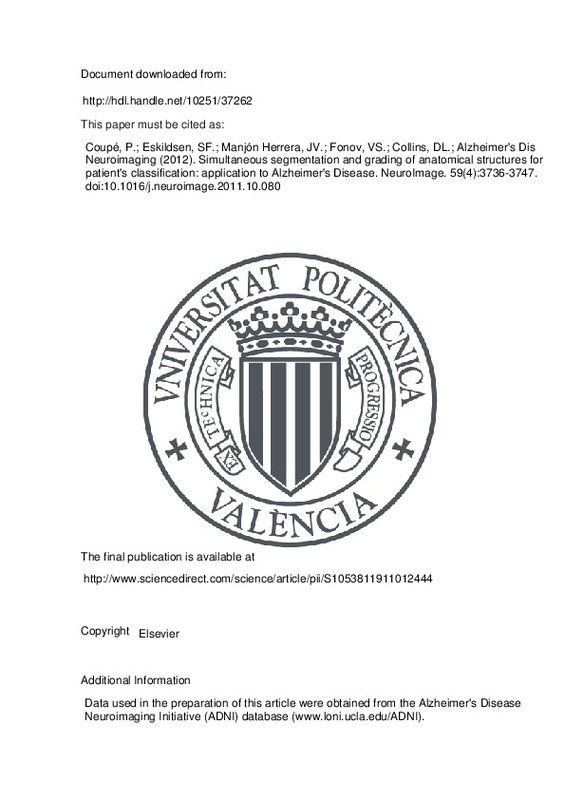JavaScript is disabled for your browser. Some features of this site may not work without it.
Buscar en RiuNet
Listar
Mi cuenta
Estadísticas
Ayuda RiuNet
Admin. UPV
Simultaneous segmentation and grading of anatomical structures for patient's classification: application to Alzheimer's Disease
Mostrar el registro sencillo del ítem
Ficheros en el ítem
| dc.contributor.author | Coupé, Pierrick
|
es_ES |
| dc.contributor.author | Eskildsen, Simon F.
|
es_ES |
| dc.contributor.author | Manjón Herrera, José Vicente
|
es_ES |
| dc.contributor.author | Fonov, Vladimir S.
|
es_ES |
| dc.contributor.author | Collins, D. Louis
|
es_ES |
| dc.contributor.author | Alzheimer's Dis Neuroimaging
|
|
| dc.date.accessioned | 2014-05-06T18:19:48Z | |
| dc.date.issued | 2012-02-15 | |
| dc.identifier.issn | 1053-8119 | |
| dc.identifier.uri | http://hdl.handle.net/10251/37262 | |
| dc.description | Data used in the preparation of this article were obtained from the Alzheimer's Disease Neuroimaging Initiative (ADNI) database (www.loni.ucla.edu/ADNI). | es_ES |
| dc.description.abstract | In this paper, we propose an innovative approach to robustly and accurately detect Alzheimer's disease (AD) based on the distinction of specific atrophic patterns of anatomical structures such as hippocampus (HC) and entorhinal cortex (EC). The proposed method simultaneously performs segmentation and grading of structures to efficiently capture the anatomical alterations caused by AD. Known as SNIPE (Scoring by Non-local Image Patch Estimator), the novel proposed grading measure is based on a nonlocal patch-based frame-work and estimates the similarity of the patch surrounding the voxel under study with all the patches present in different training populations. In this study, the training library was composed of two populations: 50 cognitively normal subjects (CN) and 50 patients with AD, randomly selected from the ADNI database. During our experiments, the classification accuracy of patients (CN vs. AD) using several biomarkers was compared: HC and EC volumes, the grade of these structures and finally the combination of their volume and their grade. Tests were completed in a leave-one-out framework using discriminant analysis. First, we showed that biomarkers based on HC provide better classification accuracy than biomarkers based on EC. Second, we demonstrated that structure grading is a more powerful measure than structure volume to distinguish both populations with a classification accuracy of 90%. Finally, by adding the ages of subjects in order to better separate age-related structural changes from disease-related anatomical alterations, SNIPE obtained a classification accuracy of 93% | es_ES |
| dc.description.sponsorship | Data collection and sharing for this project were funded by the Alzheimer's Disease Neuroimaging Initiative (ADNI) (National Institutes of Health Grant U01 AG024904). ADNI is funded by the National Insti- tute on Aging, the National Institute of Biomedical Imaging and Bioengineering, and through generous contributions from the following: Abbott, AstraZeneca AB, Bayer Schering Pharma AG, Bristol-Myers Squibb, Eisai Global Clinical Development, Elan Corporation, Genentech, GE Healthcare, GlaxoSmithKline, Innogenetics, Johnson and Johnson, Eli Lilly and Co., Medpace, Inc., Merck and Co., Inc., Novartis AG, Pfizer Inc, F. Hoffman-La Roche, Schering-Plough, Synarc, Inc., as well as non-profit partners the Alzheimer's Association and Alzheimer's Drug Discovery Foundation, with participation from the U.S. Food and Drug Administration. Private sector contributions to ADNI are facilitated by the Foundation for the National Institutes of Health (www.fnih.org). The grantee organization is the Northern California Institute for Research and Education, and the study is coordinated by the Alzheimer's Disease Cooperative Study at the University of California, San Diego. ADNI data are disseminated by the Laboratory for Neuro Imaging at the University of California, Los Angeles. This research was also supported by NIH grants P30AG010129, K01 AG030514, and the Dana Foundation. | en_EN |
| dc.format.extent | 12 | es_ES |
| dc.language | Inglés | es_ES |
| dc.publisher | Elsevier | es_ES |
| dc.relation.ispartof | NeuroImage | es_ES |
| dc.rights | Reserva de todos los derechos | es_ES |
| dc.subject | Hippocampus | es_ES |
| dc.subject | Hippocampus volume | es_ES |
| dc.subject | Hippocampus grading | es_ES |
| dc.subject | Patient's classification | es_ES |
| dc.subject | Nonlocal means estimator | es_ES |
| dc.subject | Alzheimer's disease | es_ES |
| dc.subject | Entorhinal cortex | es_ES |
| dc.subject.classification | FISICA APLICADA | es_ES |
| dc.title | Simultaneous segmentation and grading of anatomical structures for patient's classification: application to Alzheimer's Disease | es_ES |
| dc.type | Artículo | es_ES |
| dc.embargo.lift | 10000-01-01 | |
| dc.embargo.terms | forever | es_ES |
| dc.identifier.doi | 10.1016/j.neuroimage.2011.10.080 | |
| dc.relation.projectID | info:eu-repo/grantAgreement/CIHR//MOP-84360/ | es_ES |
| dc.relation.projectID | info:eu-repo/grantAgreement/CIHR//Cda (CECR)-Gevas-OE016/CA/ | es_ES |
| dc.relation.projectID | info:eu-repo/grantAgreement/CIHR//MOP-111169/ | es_ES |
| dc.relation.projectID | info:eu-repo/grantAgreement/MICINN//RD07%2F0067%2F2001/ES/RED TEMÁTICA DE INVESTIGACIÓN COOPERATIVA EN BIOMEDICINA COMPUTACIONAL/ / | es_ES |
| dc.rights.accessRights | Abierto | es_ES |
| dc.contributor.affiliation | Universitat Politècnica de València. Departamento de Física Aplicada - Departament de Física Aplicada | es_ES |
| dc.contributor.affiliation | Universitat Politècnica de València. Instituto Universitario de Aplicaciones de las Tecnologías de la Información - Institut Universitari d'Aplicacions de les Tecnologies de la Informació | es_ES |
| dc.description.bibliographicCitation | Coupé, P.; Eskildsen, SF.; Manjón Herrera, JV.; Fonov, VS.; Collins, DL.; Alzheimer's Dis Neuroimaging (2012). Simultaneous segmentation and grading of anatomical structures for patient's classification: application to Alzheimer's Disease. NeuroImage. 59(4):3736-3747. https://doi.org/10.1016/j.neuroimage.2011.10.080 | es_ES |
| dc.description.accrualMethod | S | es_ES |
| dc.relation.publisherversion | http://www.sciencedirect.com/science/article/pii/S1053811911012444 | es_ES |
| dc.description.upvformatpinicio | 3736 | es_ES |
| dc.description.upvformatpfin | 3747 | es_ES |
| dc.type.version | info:eu-repo/semantics/publishedVersion | es_ES |
| dc.description.volume | 59 | es_ES |
| dc.description.issue | 4 | es_ES |
| dc.relation.senia | 237115 | |
| dc.identifier.eissn | 1095-9572 | |
| dc.identifier.pmid | 22094645 | en_EN |
| dc.contributor.funder | Ministerio de Ciencia e Innovación | es_ES |
| dc.contributor.funder | Canadian Institutes of Health Research | es_ES |







![[Cerrado]](/themes/UPV/images/candado.png)

